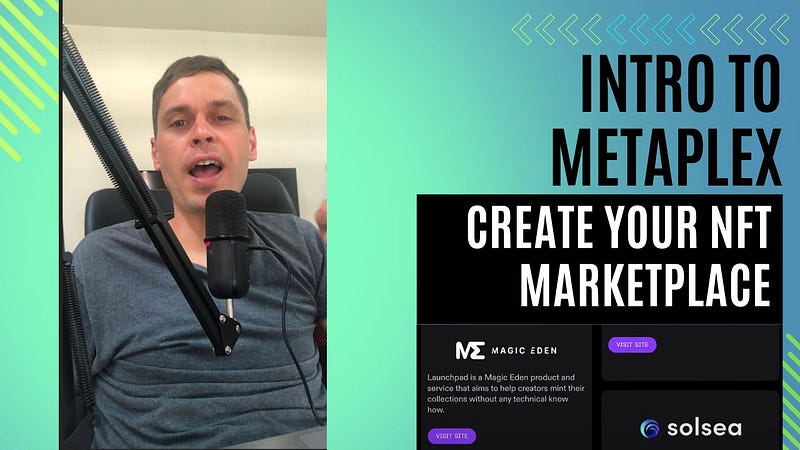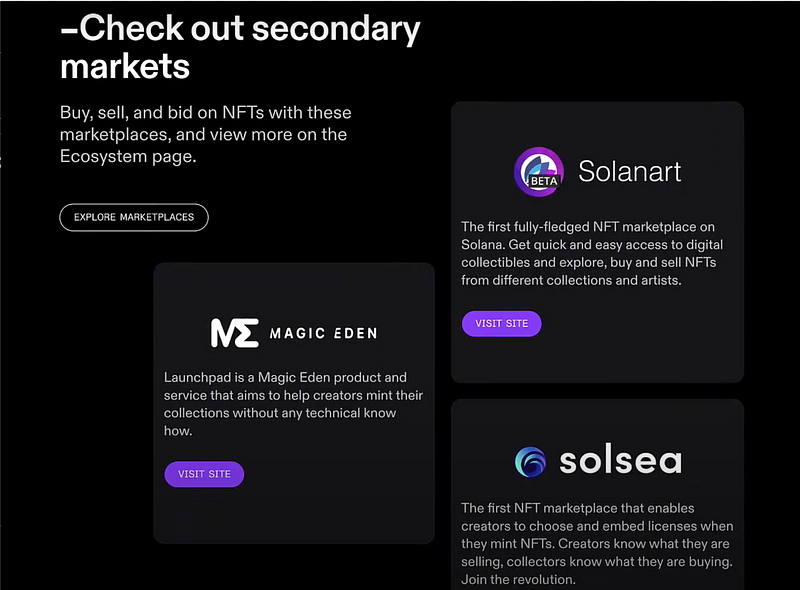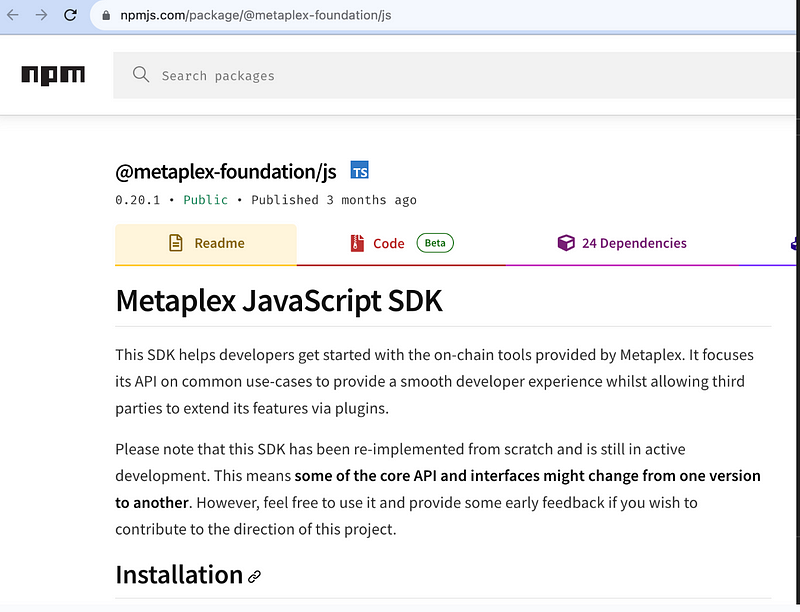Intro to Metaplex — Create your Solana NFT Marketplace
Metaplex is the Industry Standard for Solana NFTs, a collection of tools for creators and developers to MINT and create NFT Marketplaces 🚀
Not a member? read the article 👉 here

Intro to Metaplex
The Metaplex Protocol is a platform that operates on the Solana blockchain, which is known for its high speed and low transaction costs. The primary purpose of Metaplex is to simplify and democratize the process of dealing with digital assets, specialize and focus on Non-Fungible Tokens (NFTs). NFTs are unique digital items that can represent artwork, collectibles, and more, each with a distinct value and ownership record on the blockchain.
✅ Metaplex is the Solana Industry Standard for NFTs.
✅ launch your own NFT projects and storefronts with the help of audited and strategic Smart Contracts Programs.

✅ Token Metadata one of Metaplex’s core products defines the Digital ownership standard for interoperability

Solana Programs
✅ Solana distinguishes between logic and data by using Programs for operational logic and Accounts for external data storage, enhancing modularity and scalability.
By identifying non-overlapping transactions that can be run in parallel.
✅ Programs on Solana are executed in parallel using different Accounts, boosting performance by allowing simultaneous processing of transactions.
✅ Instructions within Solana Programs serve as API endpoints, enabling interaction with Accounts through specific parameters and constraints for execution.
Solana Accounts
✅ Solana Accounts are containers for data, represented as arrays of bytes linked to unique addresses derived from cryptographic key pairs.
✅ Ownership and control of an Account are determined by the private key, allowing the holder to modify the stored data under program rules.
✅ Upon creation, Accounts are initialized by a Program that sets its structure and provides Instructions for data interaction.
What does Solana Accounts can hold?
1. SOL (Native Currency): The most basic use of a Solana account is to hold SOL, the native cryptocurrency of the Solana blockchain. SOL is used to pay for transaction fees and can be staked to participate in the network’s consensus mechanism.
2. Token Balances: Solana supports the creation of SPL tokens (Solana Program Library tokens), which are analogous to ERC-20 tokens on Ethereum. An account can hold balances of any SPL tokens, in addition to SOL.
3. Smart Contract State: Accounts can store the state of smart contracts (referred to as programs on Solana). Since Solana uses a unique model where programs and data are separated, an account can be designated to hold the data (state) that a program operates on. This state can include anything from user balances, and NFT metadata, to more complex application-specific data.
4. Program Code: An account can also contain the compiled bytecode of a Solana program (smart contract). This makes the program executable on the blockchain. The program account is marked as executable and is immutable, meaning its contents cannot be changed once set, ensuring the integrity of the code that runs on the network.
5. NFT Metadata and Ownership Information: Through the use of the Metaplex protocol on Solana, accounts are used to represent NFTs (non-fungible tokens). These accounts hold metadata (such as the NFT’s name, description, and URI for off-chain assets) and ownership information.
Who can modify a Solana Account?
1. Account Owner
Program-Owned Accounts: Most accounts on Solana are owned by programs (smart contracts). Only the program that owns an account can modify its data. For example, a token account for an SPL token is owned by the SPL Token program, and only transactions invoked by this program can modify the account’s balance or other data.
User-Owned Accounts: Solana accounts that hold SOL or are used for staking are typically owned by the user’s private key. Only the holder of the private key associated with an account can initiate transactions to modify it, such as transferring SOL or changing stake delegations.
2. Signers
An account can be modified by transactions that are signed by the account’s private key. In transactions involving multiple accounts, such as transferring tokens from one account to another, the transaction must be signed by the private keys of all accounts required to authorize the transaction. This ensures that modifications are made explicitly with the permission of the account holders.
PDAs Explained
Program Derived Addresses (PDAs) in Solana are special account addresses created not from a typical cryptographic key pair but algorithmically from a program’s public key and possibly extra data (seeds). This method ensures that PDAs are unique to the program creating them, preventing other programs from accidentally or maliciously accessing the same addresses. PDAs are useful for actions like signing transactions on behalf of a program or creating predictable, secure account addresses. By design, PDAs avoid conflicts with normal cryptographic addresses by ensuring they don’t fall on the same mathematical curve used for generating public-private key pairs, using a technique called a “bump” to adjust the address if necessary.

Instructions
Interaction Mechanism: Instructions are how users tell a Program what actions to perform. They can be combined into a single transaction that’s sent to the Solana blockchain.
Atomic Transactions: A transaction on Solana is atomic, meaning it either fully succeeds or fully fails. If any instruction in a transaction fails, the entire transaction is undone to ensure consistency.
Serialization: Before sending to the network, Instructions are serialized, or converted into a structured array of bytes. This serialization includes essential information for the Program to execute the Instruction:
Discriminator: A unique identifier that helps the Program recognize the specific Instruction being executed, similar to how a function name works in traditional programming.
Accounts: Lists the Account addresses involved in the Instruction. These Accounts may be read from, written to, or both during the execution. The sequence of these addresses is crucial as it helps the Program understand the role of each Account.
Arguments: Provides additional data needed by the Instruction. While some Instructions might not require external arguments, relying instead on data from the involved Accounts, others need these specified fields to operate correctly.
Signers: Identifies which of the Accounts involved must provide a digital signature to authorize the Instruction. This is necessary for actions requiring permission from the Account holder.
Solana NFT Marketplaces built with Metaplex

How to create a Solana NFT Marketplace using Metaplex?
✅ Metaplex Program Library (MPL): Smart contracts for NFT minting, auctions, and metadata management.
✅ Metaplex JavaScript SDK: For interacting with the Metaplex programs in a web application.
✅ Token Metadata Program: Manages metadata for on-chain tokens, crucial for NFTs to store information like the asset’s name, description, and the URI for the asset’s media file.
✅ Auction Program: Enables creating and managing auctions for NFTs, including features like English auctions, Dutch auctions, and sealed bids.
✅ Metaplex Storefront: A customizable front-end template provided by Metaplex that can be used as a starting point for your marketplace.
✅ Candy Machine: For minting NFTs in batches, allowing creators to launch entire collections at once.
✅ Vault Program: Manages the locking and unlocking of NFTs or other tokens, useful for implementing features like escrow services in trades.


Conclusion
True empowerment can be achieved via web3, creating an NFT marketplace is an apotheotic endeavor, for hard-working people, and I recommend in my humble opinion to fund your project via blockchain.
Never give up on your dreams!
Ascendance.dev
Follow me on X





